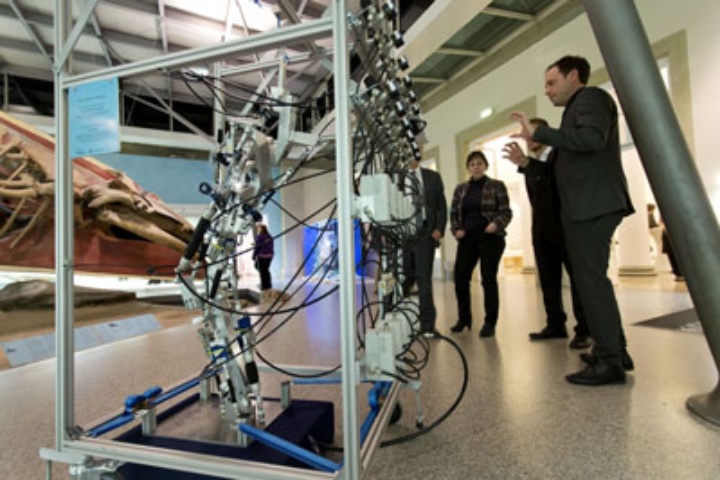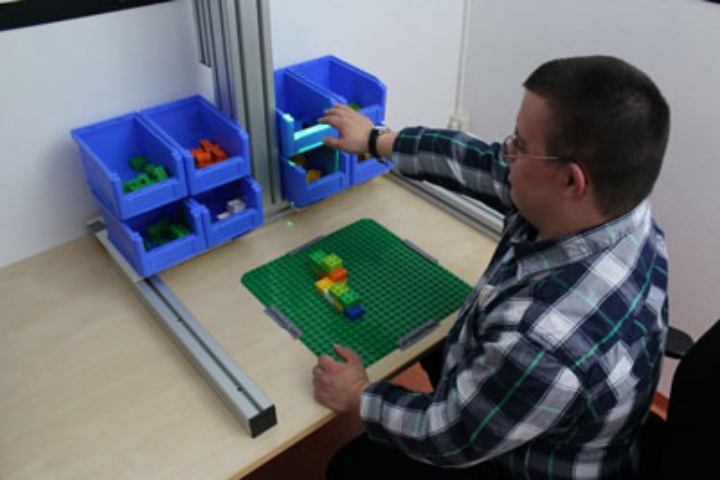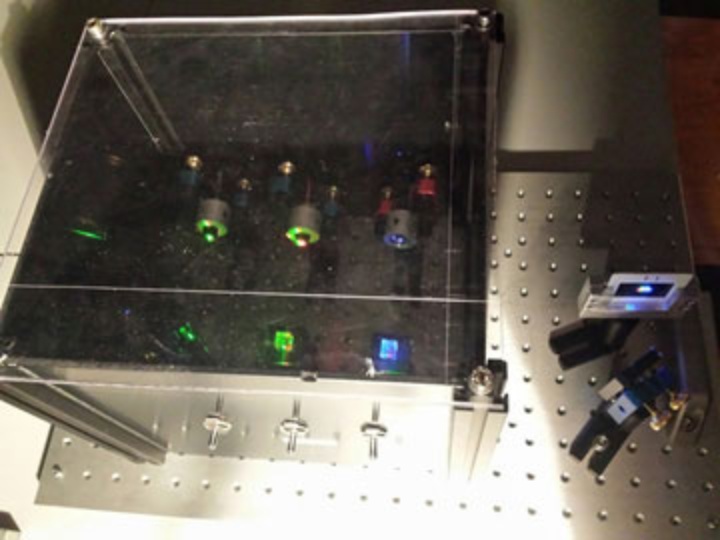After its successful trade fair debut last year, the University of Stuttgart will once again be presenting its diverse, ground breaking research achievements at Hannover Messe 2016, the global trade fair forum for product innovations along the entire industrial value-added chain. As a co-exhibitor at the “Baden-Württemberg joint booth”, which has been organized by Baden-Württemberg International (bw-i), the state’s competence center for the internationalization of business, science and research, the University will again be showing the visiting public from all over the world its cutting-edge research. The exhibition concept, which was widely acclaimed last year will also impress visitors at this year’s trade fair: the trade fair booth which built continuously during the trade fair by a KUKA robot in front of the visitors’ very eyes, has already been planned as an exhibition object itself, with which state-of-the-art material-efficient construction and process technologies will be demonstrated.
The University will take part in the trade fair from April 25 th until 29 th as part of the leading trade fair “Research & Technology” in Hall 2. This exhibition sector for research, development and technology transfer shows visionary products and applications and as a major attraction at Hannover Messe brings together representatives from all areas of business, science and politics. The University’s exhibits will demonstrate research and development as the main pillars of the economy.
With a view to the trade fair commitment in Hanover, Professor Wolfram Ressel, Rector of the University of Stuttgart, emphasizes the necessity of transferring findings from research expediently and promptly to industrial innovations: “As a research university of international ranking, we have therefore strategically realigned and intensified our activities in knowledge and technology transfer in order to provide our industrial partners access to our research achievements as efficiently as possible”. This also includes the contact point established in the Rector’s office “contactUS! – the economy meets science”, which was created with the financial support of the Ministry of Science in Baden-Württemberg.
Trade fair booth as an exhibit
The carbon-fiber-reinforced lightweight structure of the University’s trade fair booth was created using computer-aided design and simulation tools as well as an innovative, coreless robotic winding process for fiber composite components. The Institutes for Computer-Based Design (ICD) and for Supporting Structure and Constructive Design (ITKE), which were involved in the conceptual design and production of the exhibition booth, illustrate with this construction innovative design possibilities for architecture.
Further highlights of the trade fair presentation:
ARENA2036
The mission of the ambitious research program ARENA2036 – Active Research Environment for the Next Generation of Automobiles – is the development of a sustainable production model 4.0 and a technology change that achieves individual mobility with minimal use of resources. Versatile forms of production provide the key in the form of intelligent, function-integrated, multi-material lightweight construction. The research factory is working to fundamentally change the industrial production principle, by replacing the current conveyor belt production with the versatile, sustainable production of the future, Industry 4.0.
The research vehicle on exhibit F 125 ! anticipates trends of the future and paves the way for the implementation of an innovative vehicle concept. With this the designers wish to determine the future of the automobile and acquire insight into the mobile world of tomorrow: from the chassis concept to drive engineering, the operating, communication and safety equipment, as well as the design. With a combination of fiber-reinforced plastics with a high share of carbon fibers, light metals and high-strength steels as well as hybrid materials, all perfectly adapted to specific demands, the research vehicle demonstrates the spectrum of application possibilities.
SimTech Cluster of Excellence
Simulation Technology Cluster of Excellence (SimTech) is an interdisciplinary research association at the University of Stuttgart in the research field of computer simulation. In SimTech over 200 scientists deal with bundling simulation models and methods, which have only been developed in isolation up to now, into one systems science. For this purpose researchers from the fields of engineering sciences, mathematics, computer science, natural sciences, as well as the humanities and social sciences work closely together in the cluster. With its cross-disciplinary approach, the cluster is breaking new ground to make computer simulations even more efficient, forecasts more reliable and visualizations even more precise. SimTech was set up in 2007 as part of the Excellence Initiative of the Federal and State Governments. In 2012 the cluster was given a financial commitment for a further five years.
Junior professor Syn Schmitt, who conducts research within the interdisciplinary research association SimTech using simulations in the field of biomechanics, will be presenting a leg robot at Hannover Messe. Technical machines such as leg robots can contribute towards the development of a digital human model. With the help of such so-called bio-robots, basic principles of biological cybernetics and biophysics can be tested in a real environment.
With the development of a digital human model the fundamental question should be answered as to how sensory information in the human body is converted into movement instructions – and how movement is created and controlled. In this project the bio-robots help the scientists by checking the digital simulation of a human model. Moreover, bio-robots show to what extent the findings from biology can be transferred to technical machines.
The topic of human-computer interaction becomes a central challenge with the increasing digitalization of the working world. The working group “Human Computer Interaction Group” under the supervision of SimTech-Professor Albrecht Schmidt from the Institute for Visualization and Interactive Systems (VIS) is researching new interaction technologies and innovative concepts for intuitive user interfaces. The aim thereby is to reduce the cognitive demands on the users when using digital technologies and to ensure simple use. The exhibition booth presents results from the European project MeSch and the BMWi-funded project MotionEAP.
In the project MeSch a software platform was developed for the Internet of Things. The focus of the project rests on a very simple integration of various embedded hardware, support of wireless networks, and an approach for distributed applications embedded in objects that is programmed intuitively. A platform will be demonstrated that enables the programming of wireless networked intelligent objects.
The project MotionEAP has the aim of supporting manual work processes in production and maintenance. For this purpose the information required for a task is displayed at the right time directly in the workplace. Cameras and sensors recognize the various work steps, such as the removal of parts, assembly of parts and the use of tools. The actions of the workers are compared with abstract implementation plans and relevant information is projected directly onto the workplace. This enables teach-in processes to be accelerated, cognitive demands on workers to be reduced and an error-free production to be realized. A system will be demonstrated that supports workers in manual production by embedding augmented reality information, and which recognizes and prevents errors in the production process.
Center for Integrated Quantum Science and Technology
The Universities of Stuttgart and Ulm, together with the Max Planck Institute for Solid State Research in Stuttgart, have founded an interdisciplinary Center for Quantum Science and Technology (IQST) that goes beyond the boundaries of the institutions and their locations. As a unique cooperation of its kind in Germany, the center brings scientists and users from various disciplines together in order to jointly research the enormous potential of quantum physics and to utilize it for applications. The progressing miniaturization of technology inevitably leads to the world of the smallest particles, where the laws of quantum physics govern. Mastering them and making them available for various uses, such as efficient computers, tap-proof data transfer, extremely precise biomedical sensors or low-loss energy management requires an integrated approach in fundamental research that is realized in IQST.
It is known from quantum mechanics that light has the properties of waves and that interference processes result from this. An exhibition experiment conducted by the IQST will show trade fair visitors these wave properties of light and offer the possibility to adjust laser-light in order to examine the interference effects and to measure a gap smaller than 100nm.
A ferrofluid comprises miniscule iron particles that are dissolved in oil or water. If a strong magnetic field is positioned vertically to the ferrofluid surface, this leads to so-called Rosensweig instability. An exhibit will offer visitors the opportunity to generate different aesthetic patterns themselves. When observing these patterns the boundaries between physics and art appear to be eliminated.
Night of Innovations
The University of Stuttgart is also participating this year in the “Night of Innovations” on April 25 th, in which the top representatives from science, industry and politics traditionally come together to discuss various innovations.
Supporting program
The TU9, the association of leading technical universities in Germany, will use two slots in the Talk-Ing-Lounge (event format of VDI) on April 25 th and 26 th (from 3.15 pm until 4 pm on both days at the VDI booth, Hall 2 C 40) for information activities. The Rector of the University of Stuttgart, Wolfram Ressel, and other rectors and presidents from the TU9 universities will discuss with senior representatives from VDI research topics such as Industry 4.0, renewable energy, electro-mobility and medical technology.




